Abstract
A physiologically based pharmacokinetic model was used to amalgamate information obtained in rats and man by various routes of exposure to trichloroethylene (TRI) and tetrachloroethylene (TETRA). Since there have been no pharmacokinetic data on drinking water exposure, drinking water exposure to TRI was conducted in rats using 14C-TRI. Several partition coefficients of TRI and TETRA were also determined in the present study. Simulations of the kinetics of TRI and TETRA were made with the unified physiologically based pharmacokinetic model to determine whether reported pharmacokinetic data from different routes of exposure to TRI and TETRA (inhalation, intravenous, drinking water in rats, and inhalation in man) could be simulated. The results indicated that the unified model used in this study successfully simulates the pharmacokinetics of TRI and TETRA irrespective of the routes and exposure intensities. Subsequently, sensitivity analyses were performed. Since both TRI and TETRA require bioactivation to produce their toxicity, the amounts metabolised in the body were used as indicators of toxicity. Vmax (maximum velocity of metabolism in the liver), alveolar ventilation, and the blood/air partition coefficient had a more profound effect than other factors on the amounts of these chemicals metabolised when parameter values were altered. The model was applied to simulate the biologically permissible values of exhaled air concentration and blood concentration of these compounds for monitoring exposure intensities in occupational settings. The simulated maximum permissible values showed good agreement with those obtained by field studies. Finally, the model was applied to the risk assessment of drinking water exposures to TRI and TETRA, assuming that a man weighing 70 kg drinks 2 l of the most contaminated drinking water ever reported in the US; 32 ppb for TRI and 5 ppb for TETRA. The simulated metabolised amounts of TRI and TETRA under steady state condition in man were a fifth of an order of magnitude lower than non-cancer causing metabolised amounts of TRI and TETRA in rats through inhalation.
Full text
PDF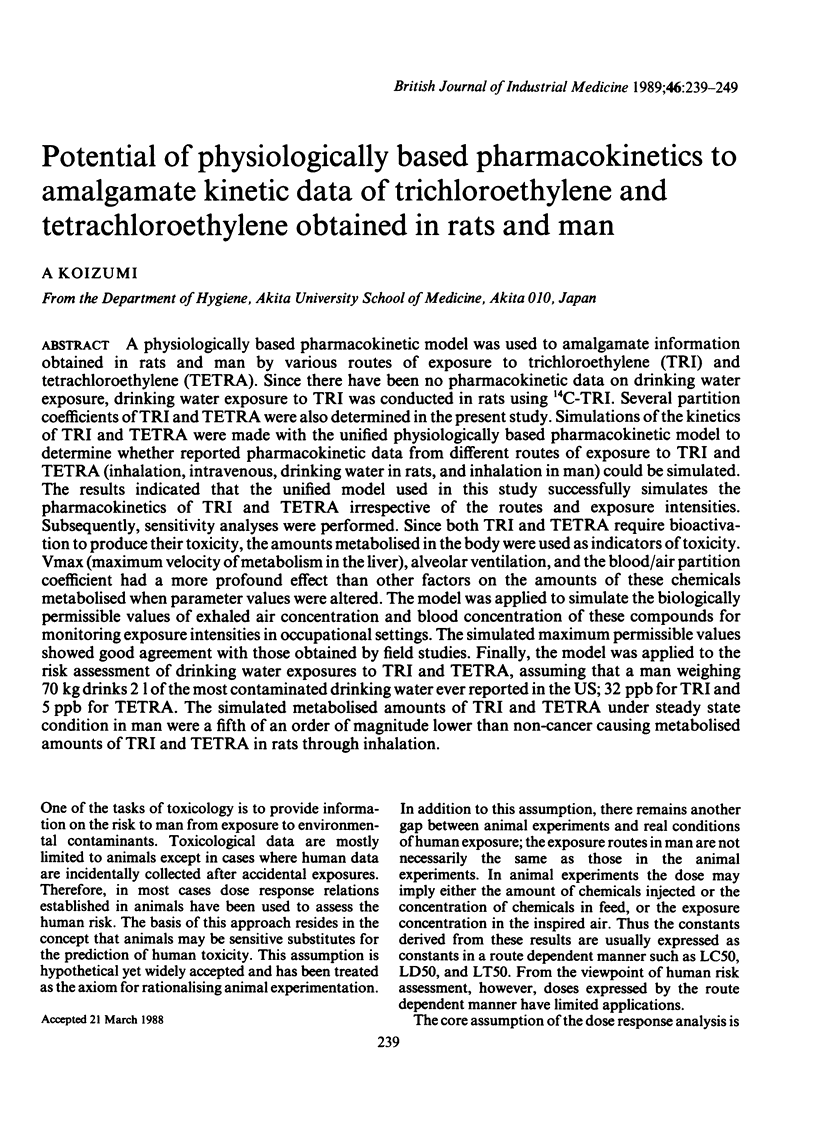
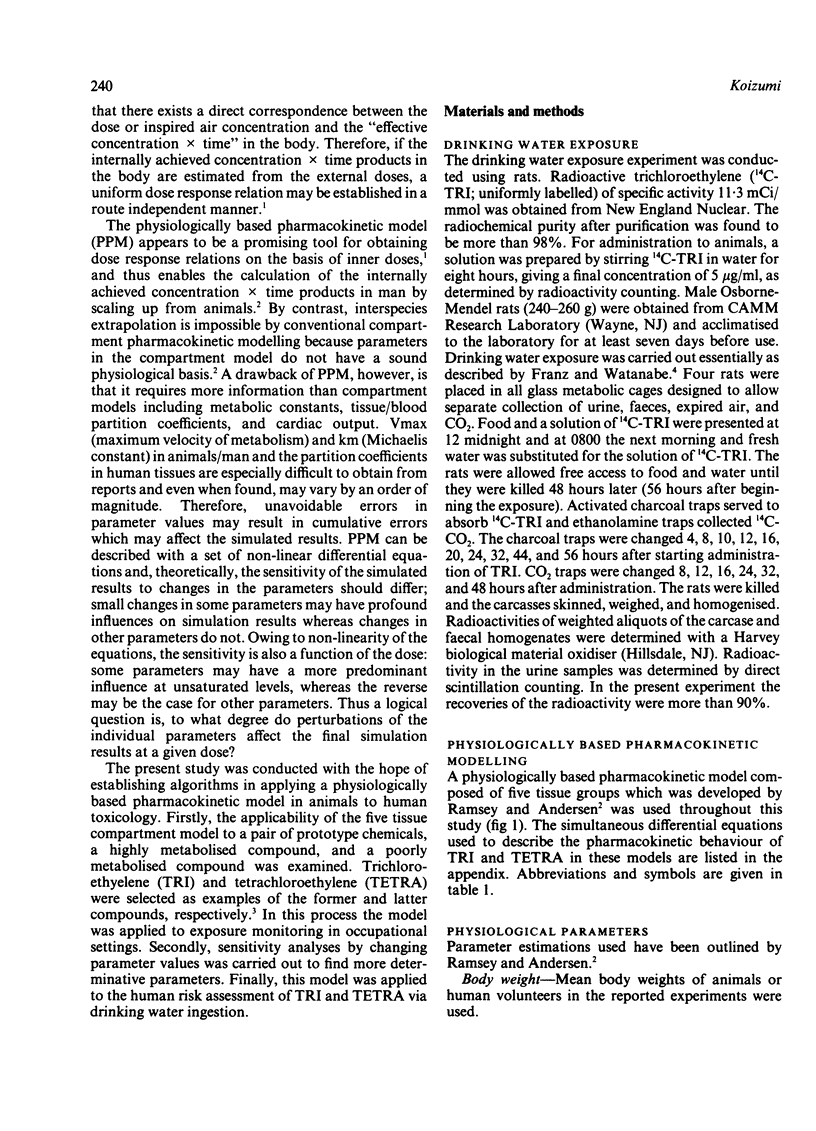
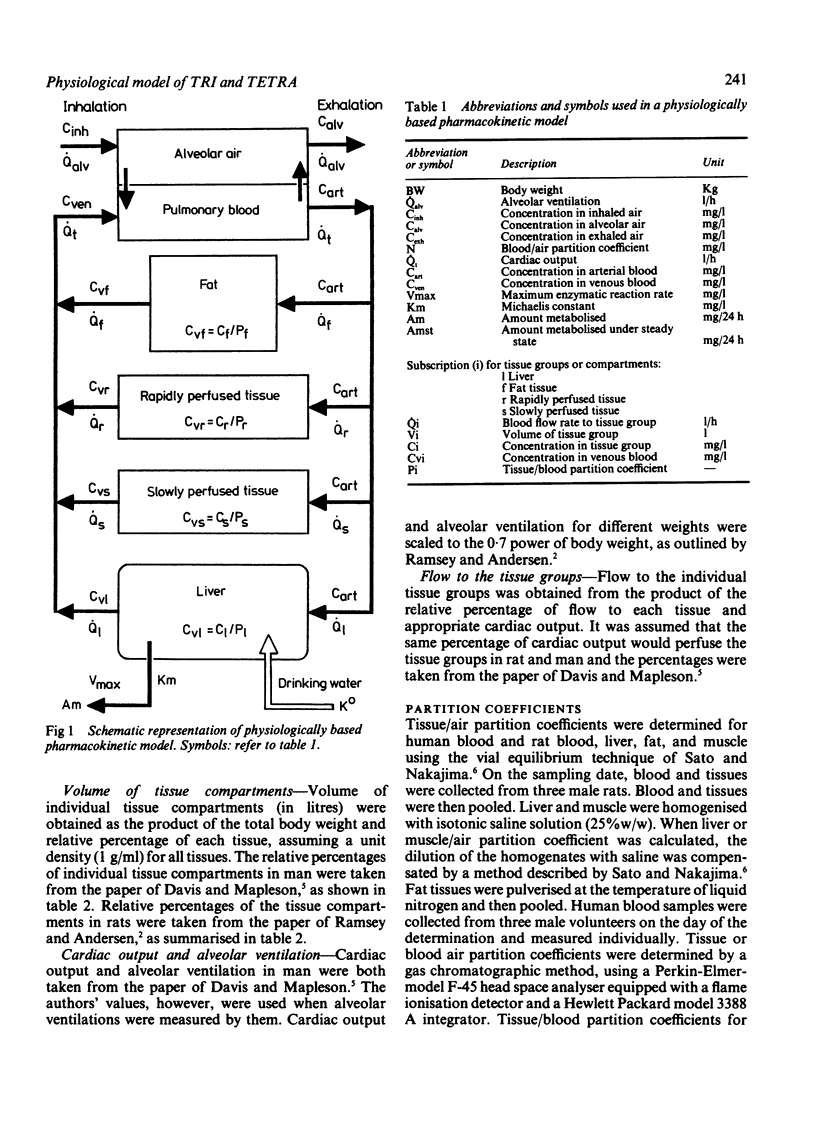
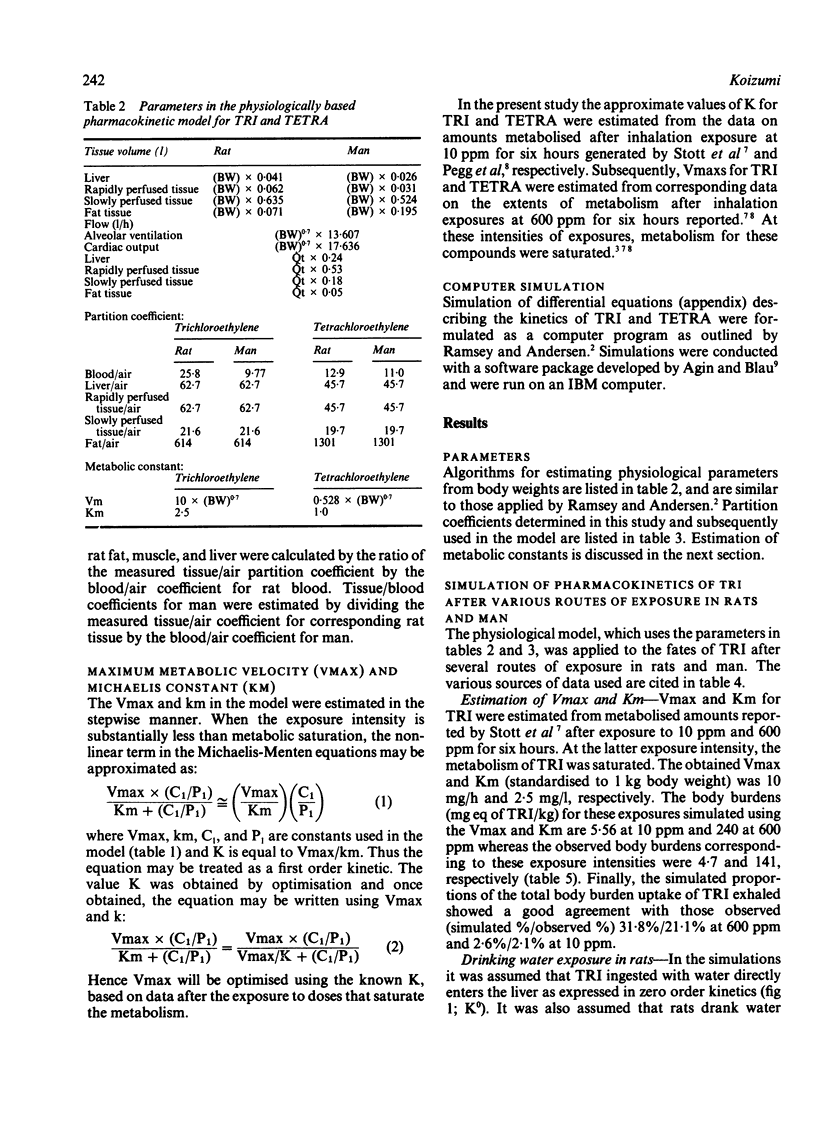
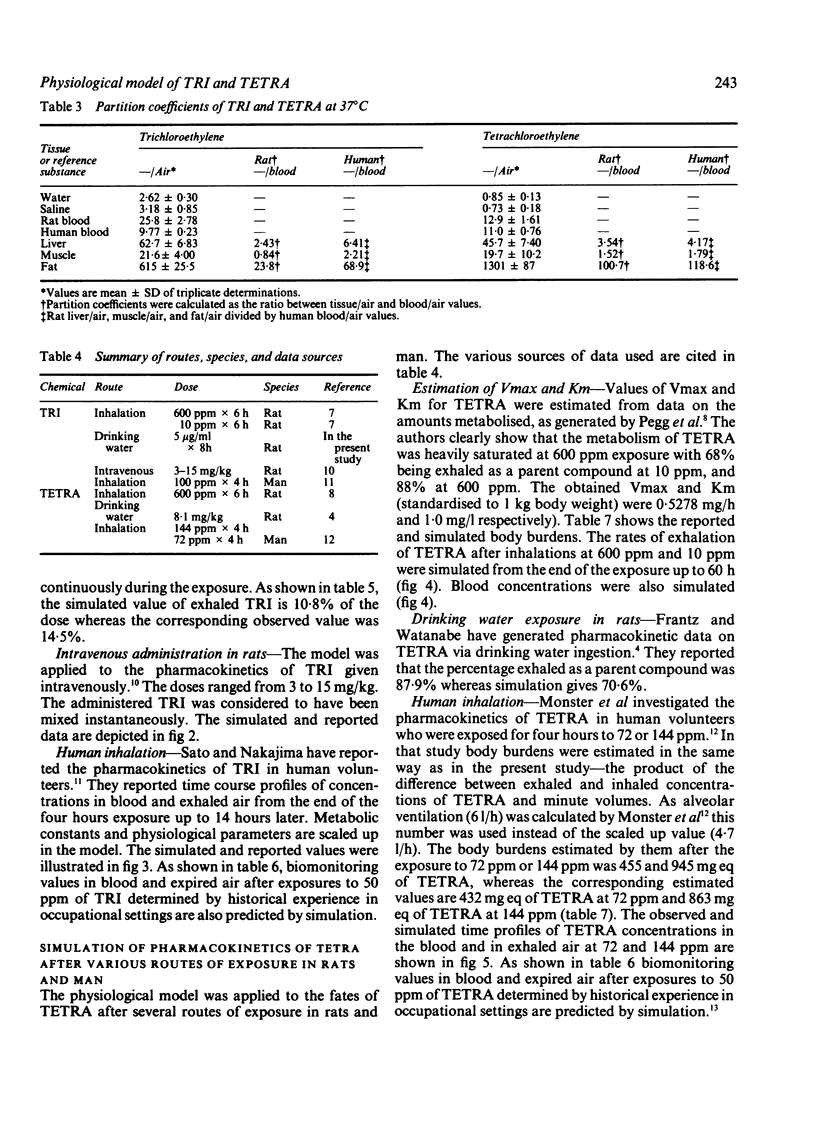
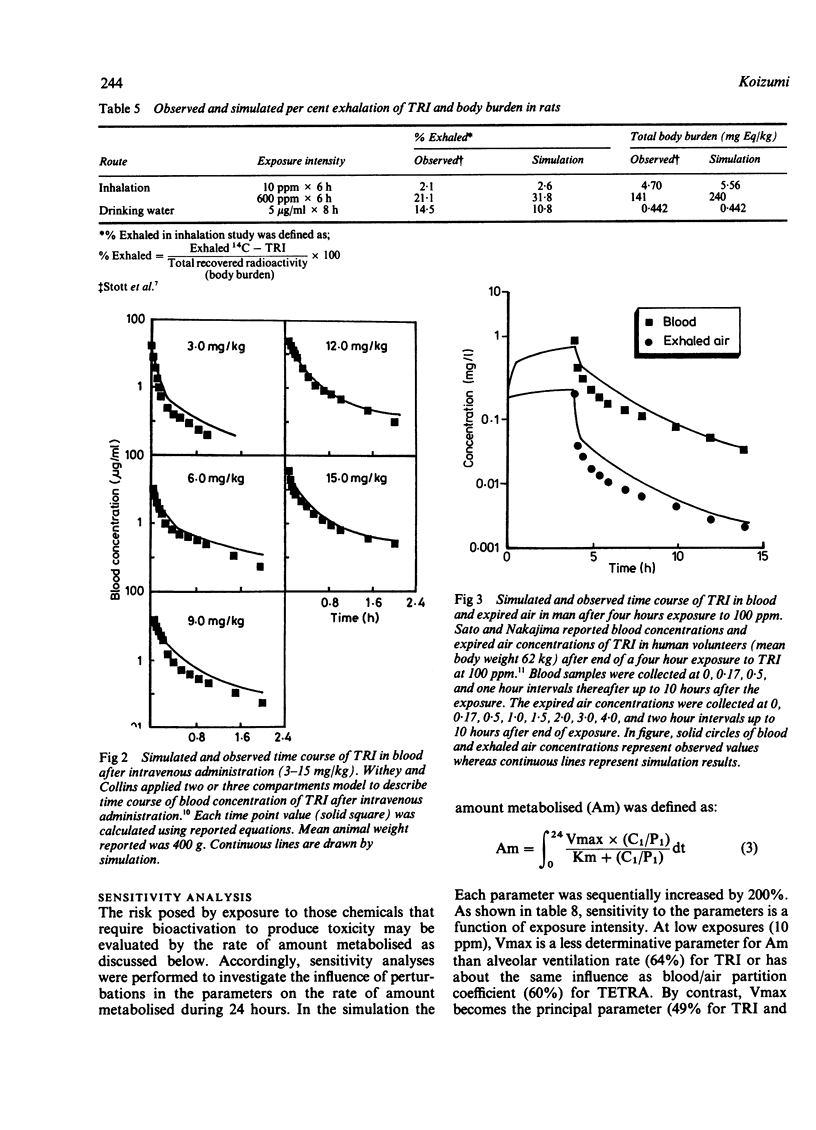
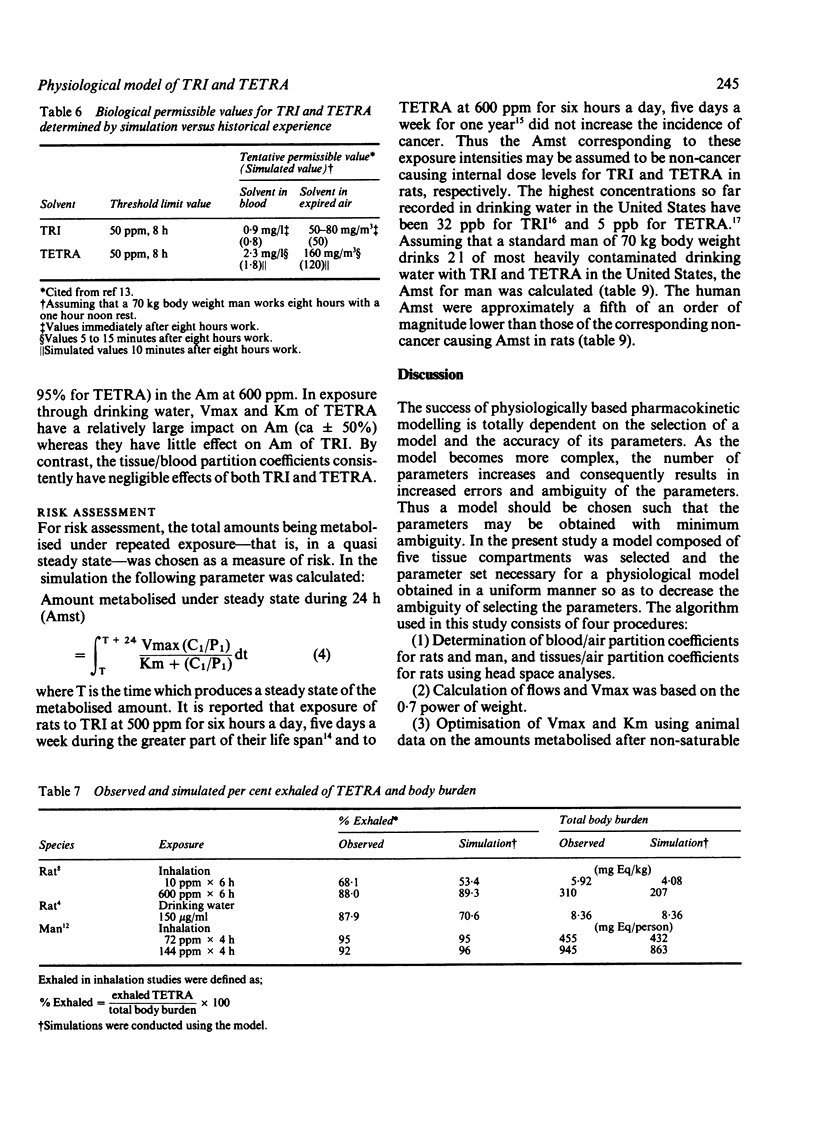
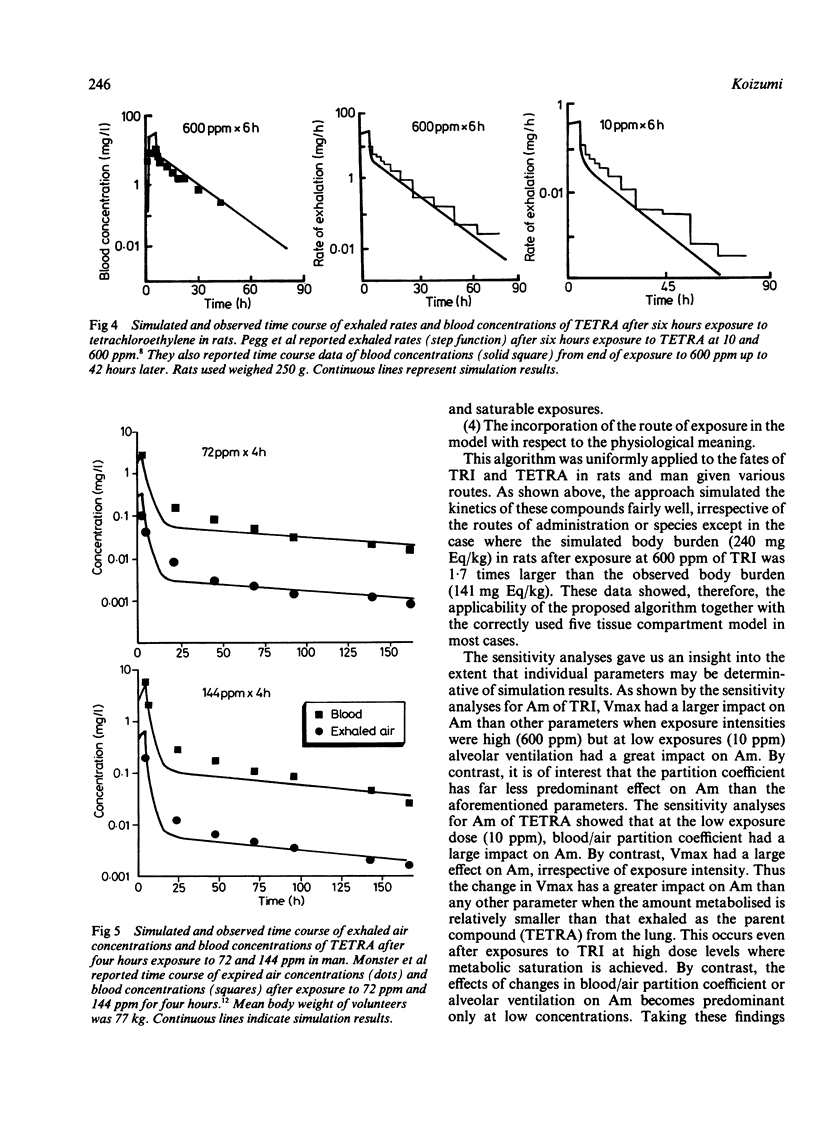
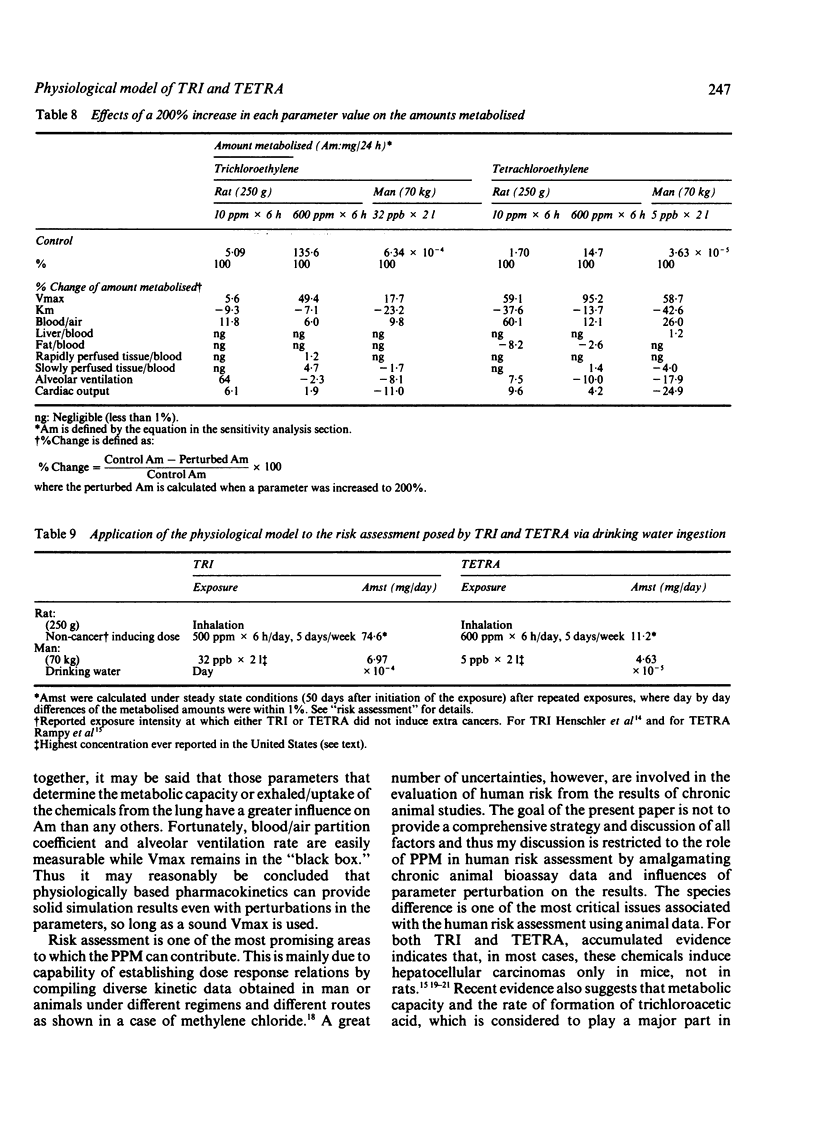
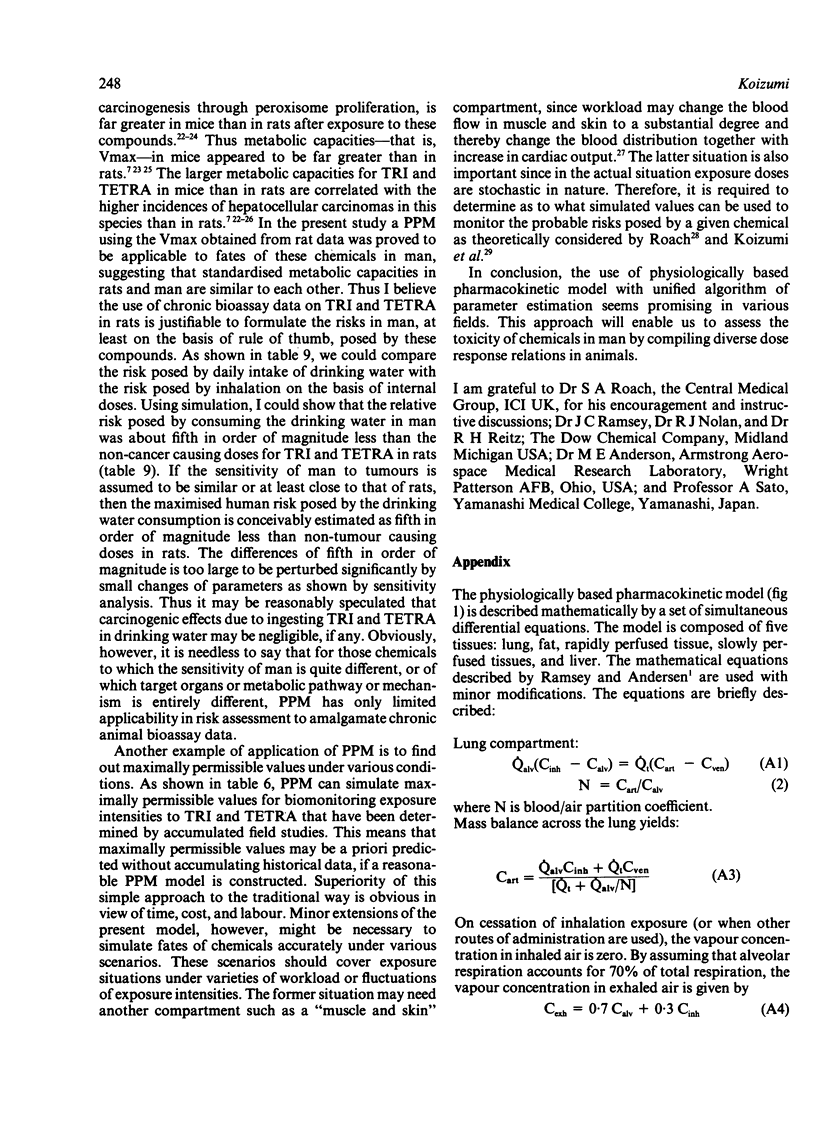
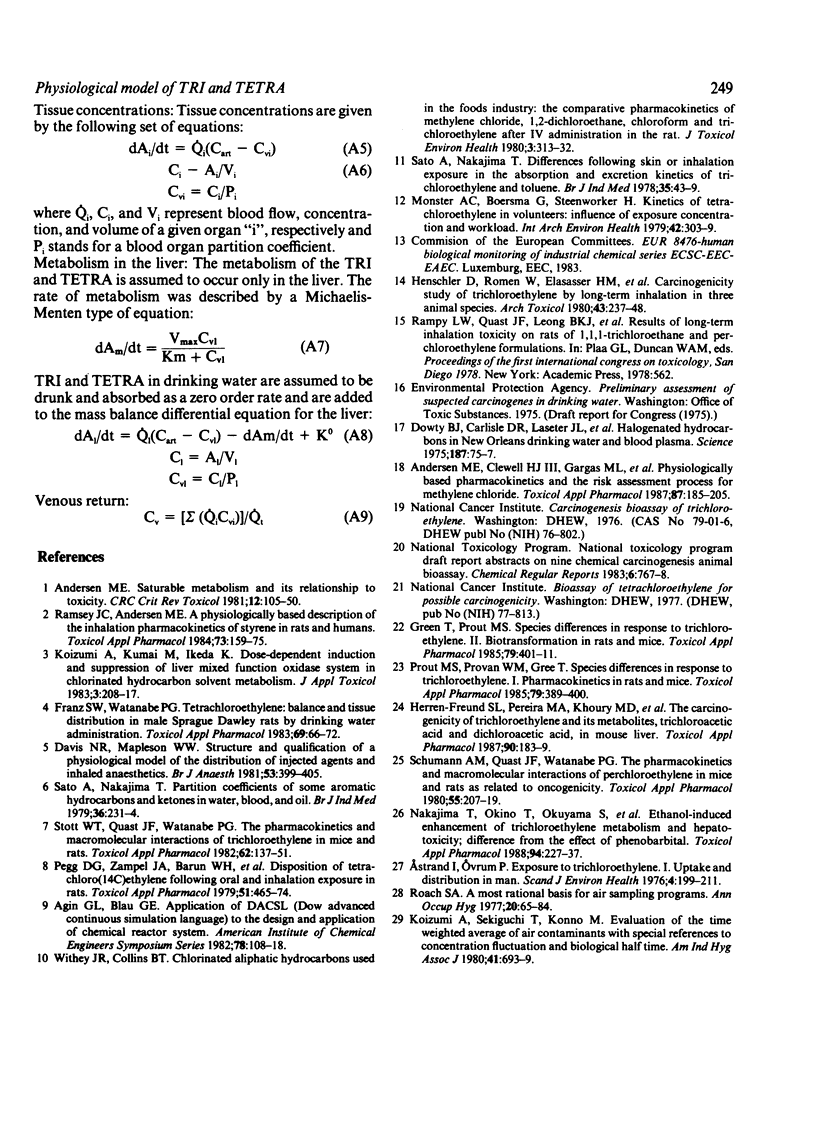
Selected References
These references are in PubMed. This may not be the complete list of references from this article.
- Andersen M. E., Clewell H. J., 3rd, Gargas M. L., Smith F. A., Reitz R. H. Physiologically based pharmacokinetics and the risk assessment process for methylene chloride. Toxicol Appl Pharmacol. 1987 Feb;87(2):185–205. doi: 10.1016/0041-008x(87)90281-x. [DOI] [PubMed] [Google Scholar]
- Andersen M. E. Saturable metabolism and its relationship to toxicity. Crit Rev Toxicol. 1981 May;9(2):105–150. doi: 10.3109/10408448109059563. [DOI] [PubMed] [Google Scholar]
- Astrand I., Ovrum P. Exposure to trichloroethylene I. Uptake and distribution in man. Scand J Work Environ Health. 1976 Dec;2(4):199–211. [PubMed] [Google Scholar]
- Davis N. R., Mapleson W. W. Structure and quantification of a physiological model of the distribution of injected agents and inhaled anaesthetics. Br J Anaesth. 1981 Apr;53(4):399–405. doi: 10.1093/bja/53.4.399. [DOI] [PubMed] [Google Scholar]
- Dowty B., Carlisle D., Laseter J. L., Storer J. Halogenated hydrocarbons in New Orleans drinking water and blood plasma. Science. 1975 Jan 10;187(4171):75–77. doi: 10.1126/science.1109227. [DOI] [PubMed] [Google Scholar]
- Frantz S. W., Watanabe P. G. Tetrachloroethylene: balance and tissue distribution in male Sprague-Dawley rats by drinking-water administration. Toxicol Appl Pharmacol. 1983 Jun 15;69(1):66–72. doi: 10.1016/0041-008x(83)90120-5. [DOI] [PubMed] [Google Scholar]
- Green T., Prout M. S. Species differences in response to trichloroethylene. II. Biotransformation in rats and mice. Toxicol Appl Pharmacol. 1985 Jul;79(3):401–411. doi: 10.1016/0041-008x(85)90138-3. [DOI] [PubMed] [Google Scholar]
- Henschler D., Romen W., Elsässer H. M., Reichert D., Eder E., Radwan Z. Carcinogenicity study of trichloroethylene by longterm inhalation in three animal species. Arch Toxicol. 1980 Feb;43(4):237–248. doi: 10.1007/BF00366179. [DOI] [PubMed] [Google Scholar]
- Herren-Freund S. L., Pereira M. A., Khoury M. D., Olson G. The carcinogenicity of trichloroethylene and its metabolites, trichloroacetic acid and dichloroacetic acid, in mouse liver. Toxicol Appl Pharmacol. 1987 Sep 15;90(2):183–189. doi: 10.1016/0041-008x(87)90325-5. [DOI] [PubMed] [Google Scholar]
- Koizumi A., Kumai M., Ikeda M. Dose-dependent induction and suppression of liver mixed-function oxidase system in chlorinated hydrocarbon solvent metabolism. J Appl Toxicol. 1983 Aug;3(4):208–217. doi: 10.1002/jat.2550030409. [DOI] [PubMed] [Google Scholar]
- Koizumi A., Sekiguchi T., Konno M., Ikeda M. Evaluation of the time weighted average of air contaminants with special references to concentration fluctuation and biological half time. Am Ind Hyg Assoc J. 1980 Oct;41(10):693–699. doi: 10.1080/15298668091425527. [DOI] [PubMed] [Google Scholar]
- Monster A. C., Boersma G., Steenweg H. Kinetics of tetrachloroethylene in volunteers; influence of exposure concentration and work load. Int Arch Occup Environ Health. 1979 Jan 15;42(3-4):303–309. doi: 10.1007/BF00377784. [DOI] [PubMed] [Google Scholar]
- Nakajima T., Okino T., Okuyama S., Kaneko T., Yonekura I., Sato A. Ethanol-induced enhancement of trichloroethylene metabolism and hepatotoxicity: difference from the effect of phenobarbital. Toxicol Appl Pharmacol. 1988 Jun 30;94(2):227–237. doi: 10.1016/0041-008x(88)90264-5. [DOI] [PubMed] [Google Scholar]
- Pegg D. G., Zempel J. A., Braun W. H., Watanabe P. G. Disposition of tetrachloro(14C)ethylene following oral and inhalation exposure in rats. Toxicol Appl Pharmacol. 1979 Dec;51(3):465–474. doi: 10.1016/0041-008x(79)90371-5. [DOI] [PubMed] [Google Scholar]
- Prout M. S., Provan W. M., Green T. Species differences in response to trichloroethylene. I. Pharmacokinetics in rats and mice. Toxicol Appl Pharmacol. 1985 Jul;79(3):389–400. doi: 10.1016/0041-008x(85)90137-1. [DOI] [PubMed] [Google Scholar]
- Ramsey J. C., Andersen M. E. A physiologically based description of the inhalation pharmacokinetics of styrene in rats and humans. Toxicol Appl Pharmacol. 1984 Mar 30;73(1):159–175. doi: 10.1016/0041-008x(84)90064-4. [DOI] [PubMed] [Google Scholar]
- Roach S. A. A most rational basis for air sampling programmes. Ann Occup Hyg. 1977 Jul;20(1):65–84. doi: 10.1093/annhyg/20.1.65. [DOI] [PubMed] [Google Scholar]
- Sato A., Nakajima T. Differences following skin or inhalation exposure in the absorption and excretion kinetics of trichloroethylene and toluene. Br J Ind Med. 1978 Feb;35(1):43–49. doi: 10.1136/oem.35.1.43. [DOI] [PMC free article] [PubMed] [Google Scholar]
- Sato A., Nakajima T. Partition coefficients of some aromatic hydrocarbons and ketones in water, blood and oil. Br J Ind Med. 1979 Aug;36(3):231–234. doi: 10.1136/oem.36.3.231. [DOI] [PMC free article] [PubMed] [Google Scholar]
- Schumann A. M., Quast J. F., Watanabe P. G. The pharmacokinetics and macromolecular interactions of perchloroethylene in mice and rats as related to oncogenicity. Toxicol Appl Pharmacol. 1980 Sep 15;55(2):207–219. doi: 10.1016/0041-008x(80)90082-4. [DOI] [PubMed] [Google Scholar]
- Stott W. T., Quast J. F., Watanabe P. G. The pharmacokinetics and macromolecular interactions of trichloroethylene in mice and rats. Toxicol Appl Pharmacol. 1982 Jan;62(1):137–151. doi: 10.1016/0041-008x(82)90110-7. [DOI] [PubMed] [Google Scholar]
- Withey J. R., Collins B. T. Chlorinated aliphatic hydrocarbons used in the foods industry: the comparative pharmacokinetics of methylene chloride, 1,2 dichloroethane, chloroform and trichloroethylene after I.V. administration in the rat. J Environ Pathol Toxicol. 1980 Jun-Jul;3(5-6):313–332. [PubMed] [Google Scholar]


